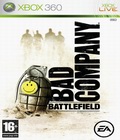From the first notes of Battlefield: Bad Company's unusually blues-inspired main theme, you can tell that this Battlefield title is going to be a little different from what gamers have come to expect in the series. Historically, the series has been about two large armies fighting each other in battles of epic scope and scale, but Bad Company features battles that are more up-close and personal. It also delves into the sometimes morally dubious reasons for the conflicts. One thing the series has never had, however, is the level of destruction that is par for the course this time around. Blowing holes into walls has simply never been this much fun.
We participated in the closed beta of Battlefield: Bad Company and had a chance to check out how it's shaping up. While previous titles have featured a more or less equal mix of infantry and vehicular action, Bad Company seems more focused on infantry combat, and the majority of the maps included in the beta had most of the combat taking place in confined areas. Vehicles such as BMPs, helicopters, Humvees and tanks are still found in every map, but the alleyways in many areas are so compact that being on foot is the only way to get things done. This is usually for the best, since vehicles are incredibly vulnerable to attack when they're on a narrow street that's flanked by buildings.
The infantry combat is somewhat simplified in comparison to the later titles in the series, with players selecting one of four combat classes. The recon class excels at long-range combat, while the assault class is best suited for the house-to-house combat that figures so predominantly in the beta. The engineer and support classes have the ability to repair vehicles and heal other players, respectively, and should be used alongside other players rather than going lone wolf. Weapons are unlockable through gameplay, so as players rank up using the in-game military ranking and experience system, they will gradually expand their arsenal. It's a system that has much more in common with Battlefield 2 than its sequel Battlefield 2142; it's no more complex or simplistic than it needs to be.
The beta didn't really touch on the plot; the only details were provided in each level's mission briefings. On one side of the conflict, you have a group of heavily armed and supplied men looking to break into crates of gold bars found scattered throughout each level, and on the other side of the fence, you have equally armed and presumably pissed-off men trying to fend them off and protect the gold. Each level of the beta was made up of this mode of play, and each level was essentially broken up into sections. At the start of the level, there are two gold crates located on one side of the map and relatively close together, and on the other side, you find the attacker's base. The goal of the attackers is to break into these two crates, either by sustained gunfire against the crate or by timed explosives that will break the crate — as long as they're not defused by the defenders.
After the first pair of crates is destroyed, the field of play is expanded to incorporate a larger area and a second set of crates, and this continues to a third set as well. To win, the defenders ultimately have to hold onto at least one crate before the mission timer is up, while the attackers not only have to worry about the time limit but also their respawn count, which is diminished by a small amount every time an attacker dies and must respawn. Battles tended to go in either direction fairly evenly, and while there were a few utter thrashings, the missions were generally pretty competitive, and neither side really had a clear advantage over the other.
A brand new twist occurs in Bad Company if the player is playing as the assault class and is trying to find the door to enter a house. In nearly any other game, this would mean one would need to circle the building to find the door, and then make his way in from there. In this game, however, explosives are easily capable of blowing holes in walls and the floor, and with that comes a whole new set of tactics. While players may hole up inside a structure and train their weapons on doorways as the only point of entry, there is nothing stopping a tank or someone with a grenade launcher from simply blowing a hole in the wall and making his own entrance.
The destructibility of the environments is as much eye candy as it is a true tactical addition to the series. At one point in our playthrough, we encountered an enemy sniper by spotting his rifle barrel sticking out of a third-story window. After aiming at the windowsill and blasting a grenade at it, the wall and a good chunk of the floor gave way, and the wounded sniper fell from his perch and died from the impact of hitting the ground. Around the two gold crates, you will usually find a beautiful little village complete with fences, but after battles have ravaged it, you'll drive through again and have a hard time believing the bombed-out building husks are the same serene place that you saw just a few minutes earlier. Buildings cannot be completely destroyed, and very little remains beyond the floors, frame and stairwells, and what is left definitely looks war-torn.
The rest of the graphics engine is nothing to scoff at, either, and is easily shaping up to be the best-looking game in the Battlefield series. Effects, such as the pre-dawn fog, look great, as does the subtle use of lighting and smoke. The character models themselves are well animated and detailed, but what steals the show is the sheer level of effects in the game. In a single village, you could look one way and see a BMP plow through a fence and mercilessly blow apart a house to get at the enemy soldiers inside, while the fierce firefight over a gold crate in another area is punctuated by muzzle flashes, while on the second floor, blasts create new holes in the walls.
At first, we were a bit skeptical as to how well Battlefield: Bad Company would perform because while it's still a Battlefield game at its core, it radically departs from the series' recent direction. The combat is much more infantry-based and somewhat simplified in terms of how customizable weapon loadouts can be, but at the same time, the gameplay has been expanded in so many ways thanks to the ability to blow holes in walls and barge in like a bull in a china shop. If nothing else, our exposure to the beta put those fears to rest, and Bad Company is genuinely shaping up to be one of the next big milestones for the Battlefield series.
More articles about Battlefield: Bad Company











 Battlefield: Bad Company drops gamers behind enemy lines with a squad of renegade soldiers who risk it all on a personal quest for gold and revenge. Featuring a deep, cinematic single-player experience loaded with adventure and dark humor, the game delivers the series' trademark sandbox gameplay in a universe where nearly everything is destructible.
Battlefield: Bad Company drops gamers behind enemy lines with a squad of renegade soldiers who risk it all on a personal quest for gold and revenge. Featuring a deep, cinematic single-player experience loaded with adventure and dark humor, the game delivers the series' trademark sandbox gameplay in a universe where nearly everything is destructible.





































